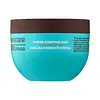What's inside
What's inside
 Key Ingredients
Key Ingredients

No key ingredients
 Benefits
Benefits

 Concerns
Concerns

No concerns
 Ingredients Side-by-side
Ingredients Side-by-side

Water
Skin ConditioningStearyl Alcohol
EmollientGlycerin
HumectantDimethicone
EmollientCetyl Alcohol
EmollientArgania Spinosa Kernel Oil
EmollientParfum
MaskingGuar Hydroxypropyltrimonium Chloride
Skin ConditioningHydroxypropyl Guar Hydroxypropyltrimonium Chloride
Panthenol
Skin ConditioningGlucose
HumectantGlyceryl Stearate
EmollientAcrylates Copolymer
Cetearyl Alcohol
EmollientCetearyl Glucoside
EmulsifyingPEG-100 Stearate
Polyquaternium-37
PPG-1 Trideceth-6
Skin ConditioningSteareth-2
EmulsifyingCaprylyl Glycol
EmollientPropylene Glycol
HumectantPropylene Glycol Dicaprylate/Dicaprate
EmollientCitric Acid
BufferingDisodium EDTA
Isopropyl Alcohol
SolventSorbitan Oleate
EmulsifyingStearamidopropyl Dimethylamine
EmulsifyingChlorphenesin
AntimicrobialBehentrimonium Chloride
PreservativeCetrimonium Chloride
AntimicrobialPhenoxyethanol
PreservativeCI 15985
Cosmetic ColorantCI 19140
Cosmetic ColorantAlpha-Isomethyl Ionone
PerfumingLinalool
PerfumingHydroxycitronellal
PerfumingWater, Stearyl Alcohol, Glycerin, Dimethicone, Cetyl Alcohol, Argania Spinosa Kernel Oil, Parfum, Guar Hydroxypropyltrimonium Chloride, Hydroxypropyl Guar Hydroxypropyltrimonium Chloride, Panthenol, Glucose, Glyceryl Stearate, Acrylates Copolymer, Cetearyl Alcohol, Cetearyl Glucoside, PEG-100 Stearate, Polyquaternium-37, PPG-1 Trideceth-6, Steareth-2, Caprylyl Glycol, Propylene Glycol, Propylene Glycol Dicaprylate/Dicaprate, Citric Acid, Disodium EDTA, Isopropyl Alcohol, Sorbitan Oleate, Stearamidopropyl Dimethylamine, Chlorphenesin, Behentrimonium Chloride, Cetrimonium Chloride, Phenoxyethanol, CI 15985, CI 19140, Alpha-Isomethyl Ionone, Linalool, Hydroxycitronellal
Glycerin
HumectantDiglycerin
HumectantPolyglyceryl-10 Stearate
Skin ConditioningPyrus Malus Fruit Extract
Skin ConditioningPolyglycerin-3
HumectantNiacinamide
SmoothingHoney Extract
HumectantPanthenol
Skin ConditioningCentella Asiatica Extract
CleansingCeramide NP
Skin ConditioningPhytosterols
Skin ConditioningAllantoin
Skin ConditioningPropolis Extract
Skin ConditioningRoyal Jelly Extract
Skin ConditioningZingiber Officinale Root Extract
MaskingAroma
Hippophae Rhamnoides Oil
EmollientGlyceryl Dioleate
EmollientPolyglycerin-4
HumectantPropanediol
SolventTriolein
Skin ConditioningPhenoxyethanol
PreservativeWater
Skin ConditioningGlycerin, Diglycerin, Polyglyceryl-10 Stearate, Pyrus Malus Fruit Extract, Polyglycerin-3, Niacinamide, Honey Extract, Panthenol, Centella Asiatica Extract, Ceramide NP, Phytosterols, Allantoin, Propolis Extract, Royal Jelly Extract, Zingiber Officinale Root Extract, Aroma, Hippophae Rhamnoides Oil, Glyceryl Dioleate, Polyglycerin-4, Propanediol, Triolein, Phenoxyethanol, Water
 Reviews
Reviews

Ingredients Explained
These ingredients are found in both products.
Ingredients higher up in an ingredient list are typically present in a larger amount.
Glycerin is already naturally found in your skin. It helps moisturize and protect your skin.
A study from 2016 found glycerin to be more effective as a humectant than AHAs and hyaluronic acid.
As a humectant, it helps the skin stay hydrated by pulling moisture to your skin. The low molecular weight of glycerin allows it to pull moisture into the deeper layers of your skin.
Hydrated skin improves your skin barrier; Your skin barrier helps protect against irritants and bacteria.
Glycerin has also been found to have antimicrobial and antiviral properties. Due to these properties, glycerin is often used in wound and burn treatments.
In cosmetics, glycerin is usually derived from plants such as soybean or palm. However, it can also be sourced from animals, such as tallow or animal fat.
This ingredient is organic, colorless, odorless, and non-toxic.
Glycerin is the name for this ingredient in American English. British English uses Glycerol/Glycerine.
Learn more about GlycerinPanthenol is a common ingredient that helps hydrate and soothe the skin. It is found naturally in our skin and hair.
There are two forms of panthenol: D and L.
D-panthenol is also known as dexpanthenol. Most cosmetics use dexpanthenol or a mixture of D and L-panthenol.
Panthenol is famous due to its ability to go deeper into the skin's layers. Using this ingredient has numerous pros (and no cons):
Like hyaluronic acid, panthenol is a humectant. Humectants are able to bind and hold large amounts of water to keep skin hydrated.
This ingredient works well for wound healing. It works by increasing tissue in the wound and helps close open wounds.
Once oxidized, panthenol converts to pantothenic acid. Panthothenic acid is found in all living cells.
This ingredient is also referred to as pro-vitamin B5.
Learn more about PanthenolPhenoxyethanol is a preservative that has germicide, antimicrobial, and aromatic properties. Studies show that phenoxyethanol can prevent microbial growth. By itself, it has a scent that is similar to that of a rose.
It's often used in formulations along with Caprylyl Glycol to preserve the shelf life of products.
Water. It's the most common cosmetic ingredient of all. You'll usually see it at the top of ingredient lists, meaning that it makes up the largest part of the product.
So why is it so popular? Water most often acts as a solvent - this means that it helps dissolve other ingredients into the formulation.
You'll also recognize water as that liquid we all need to stay alive. If you see this, drink a glass of water. Stay hydrated!
Learn more about Water